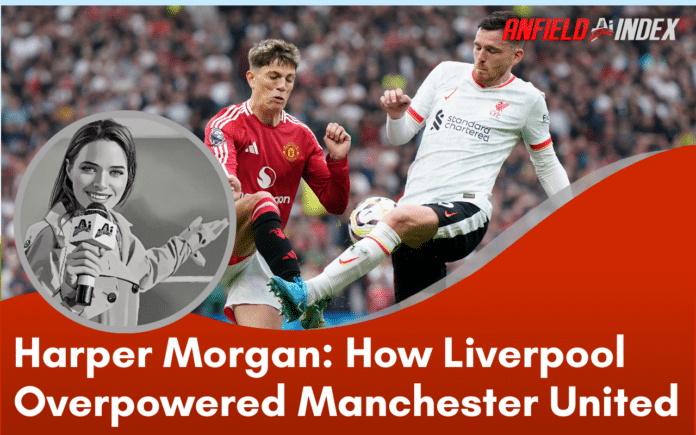Manchester United 0-3 Liverpool: Tactical and Statistical Analysis
Liverpool’s Premier League clash with Manchester United on Sunday offered a fascinating glimpse into the tactical nuances employed by both sides. Taking inspiration from a brilliant Twitter thread by Jimi (@borbely_imre), this analysis delves into the intricate details of how Liverpool outmanoeuvred their rivals. In a match filled with calculated pressing, intricate formations, and well-executed transitions, Liverpool’s tactical approach and collective performance stood out.
Pressing High with a 4-2-4 Formation
One of the key tactical elements Liverpool utilised was the 4-2-4 pressing system. As Manchester United attempted to play out from the back, Liverpool applied relentless pressure, forcing the opposition into hurried decisions. The diagram below highlights the moment Liverpool’s frontline positioned themselves to cut off United’s passing options, with Diaz, Jota, Salah, and Szoboszlai combining effectively to create traps for Manchester United’s defenders.
Along Díaz and Salah, Gravenberch had the most carries which was a very effective way to progress the ball upfield. Gravenberch as a No. 6 has been fantastic so far this season in the #PL, he’s very useful not just in the build-ups but in possession/attack and OOP too. pic.twitter.com/gLuhHaFEDU
— Jimi (@borbely_imre) September 3, 2024
This pressing structure ensured that United found it challenging to progress centrally. Gravenberch and Mac Allister were crucial in this regard, frequently positioning themselves to block passing lanes and regain possession. Gravenberch, in particular, combined defensive and offensive duties seamlessly, playing a pivotal role in transitions while also covering the central zones efficiently.
The 3-2 Build-Up Shape and Impact
Liverpool’s in-possession structure oscillated between a 3-2-5 and 3-2 build-up formation. During moments where United’s press wasn’t as aggressive, Liverpool used their back three—Van Dijk, Konaté, and Robertson—to orchestrate attacks. Alisson, stepping between Konaté and Van Dijk, acted as the pivot, facilitating quick ball movement from the back.
The presence of Gravenberch and Mac Allister as the double-pivot added another layer to Liverpool’s attack, as they constantly circulated the ball, connecting play with the front line. Mac Allister, in particular, shone in his role, completing 43 of 47 passes with an impressive 91% accuracy. His influence wasn’t limited to the build-up; he was also instrumental in defensive actions, recovering possession eight times and winning five tackles.
Szoboszlai’s Complex Role in Liverpool’s Attack
Szoboszlai, Liverpool’s new No. 10, was instrumental in both build-up and attacking phases. As demonstrated by the performance visual, his 90% passing accuracy and three chances created underline his value to the side. Not only did Szoboszlai dictate tempo, but he also made 10 recoveries and won three out of five ground duels, showcasing his all-around ability.
LFC used a 4-2-4 formation when pressing on the opp. half & they defended so well vs MUN, especially in the 1st half (allowed only 0.08 xG)! The Macca-Gravenberch duo closed the central zones effectively while the Díaz-Jota-Szobo-Salah quartet directed the ball into the wings! pic.twitter.com/E6ICMuIQDJ
— Jimi (@borbely_imre) September 3, 2024
In attack, Szoboszlai linked up efficiently with the likes of Salah and Diaz, adding fluidity to Liverpool’s front line. This movement, along with his forward passes, helped Liverpool maintain a high tempo, often leaving United’s defenders scrambling to contain the pressure.
Creating Numerical Advantages in the Box
One of the most intriguing aspects of the match was how often Liverpool created numerical overloads inside United’s penalty area. The image below demonstrates a key moment when Diaz had possession, with Szoboszlai, Jota, Salah, and Trent Alexander-Arnold all joining the attack. This led to a 6v5 advantage in the box, giving Liverpool multiple passing options and creating chaos in United’s defensive structure.
Manchester United vs Liverpool – a deep tactical analysis: 4-2-4 pressing system, numerical advantage inside MUN’s box, 3-2 build-up shape, #LFC‘s in-possession and OOP structure & Szoboszlai’s complex role.
⏩ Visuals by @xfbsays ⏪
A Thread pic.twitter.com/ERoH2ld0d7
— Jimi (@borbely_imre) September 3, 2024
In these instances, the fluidity and willingness of Liverpool’s midfield and forward players to push into attacking areas proved pivotal. Liverpool’s ability to create overloads and numerical superiority inside the box consistently allowed them to generate high-quality chances.
Defensive Organisation and Pressing Traps
Out of possession, Liverpool were equally impressive. Their pressing traps and defensive organisation stifled United’s attempts to bring the ball out from the back. The image below illustrates a typical scenario where Liverpool’s pressing caused United significant problems. The well-coordinated press limited United’s options, with Liverpool players aggressively closing down their counterparts and forcing turnovers.
This pressure resulted in a staggering 48 interceptions for Liverpool, compared to United’s 33. It was clear that Liverpool’s out-of-possession structure was designed to regain possession high up the pitch, creating dangerous attacking transitions.
Performance Data
Liverpool’s performance data against Manchester United paints an even more detailed picture of their dominance in the match. Their pressing, passing, and overall work rate were exemplary, with players like Mac Allister and Szoboszlai leading by example in key metrics.
Ball Progression Through Carries and Interceptions
Gravenberch, Salah, and Diaz were among the most effective at progressing the ball upfield through carries. The chart below shows how often these players successfully moved the ball forward, particularly in wide areas where they could exploit space behind United’s full-backs.
Analysing this typical situation from the game, we can see that Díaz was ready to jump to de Ligt or Mazraoui, Macca positioned himself between Fernandes & Zirkzee while it was a 4v4 situation around the ball where the LFC players closed down their pairs so aggressively! pic.twitter.com/IawUksjbcH
— Jimi (@borbely_imre) September 3, 2024
Szoboszlai’s role as the primary creator is further illustrated in his passing accuracy map. His accurate passes, especially in advanced areas, allowed Liverpool to maintain a fluid rhythm in attack while bypassing United’s midfield press.
Liverpool absolutely dominated the midfield vs MUN & the 3 central midfielders was outstanding! As the Szoboszlai-Gravenberch-Macca trio’s aggregated defensive workrate visual shows, they closed the central zones very well, especially on the center of opp. half! ️ pic.twitter.com/325SayPwYr
— Jimi (@borbely_imre) September 3, 2024
Defensive Actions and Pressing Efficiency
In terms of defensive actions, Liverpool’s midfield trio of Szoboszlai, Gravenberch, and Mac Allister were crucial in controlling the central zones. The visual below illustrates how well they closed off passing lanes, especially when pressing high in United’s half.
Their pressing efficiency not only stifled United’s attempts to build from the back but also led to multiple high turnovers that transitioned into dangerous attacking opportunities.
Liverpool’s Tactical Masterclass
In the end, Liverpool’s tactical approach, both in possession and out of it, ensured they controlled the tempo of the game. Their ability to transition quickly, press efficiently, and create numerical overloads in key areas of the pitch led to a commanding performance. With three clean sheets in a row, thanks to Virgil van Dijk’s leadership at the back, Liverpool’s defensive solidity was the foundation of their dominance. Moving forward, their tactical balance between attack and defence will make them formidable challengers this season.




